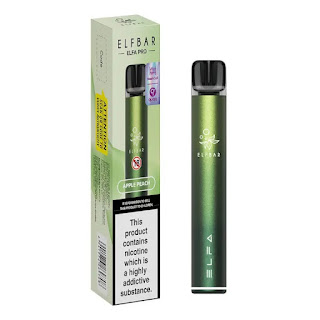Are you a smoker considering switching to vaping? Perhaps you've heard
vaping is a better choice than traditional cigarettes. The debate surrounding
vaping and smoking has been ongoing for years. While both involve inhaling
substances, vaping is generally considered a safer alternative to cigarettes.
Understanding the
Vaping vs. Smoking Debate
Vaping involves inhaling an aerosol produced by an electronic device called an e-cigarette or vape. These devices, such as the disposable Crystal Pro or the prefilled Crystal 4 in 1 pod kit, heat a liquid solution containing nicotine, flavourings, and other chemicals. The resulting vapour mimics smoking but without burning tobacco. Unlike traditional cigarettes, vaping does not involve combustion, which means there is no tar or carbon monoxide produced.
One of the primary advantages of vaping is the reduced exposure to
harmful chemicals found in traditional cigarettes. Since vaping does not
involve combustion, users are not exposed to the tar and numerous carcinogenic
compounds present in cigarette smoke. Studies have shown that switching from
smoking to vaping can improve respiratory function and cardiovascular health to
some extent. Smokers who transitioned to vaping experienced fewer respiratory
symptoms, improved lung function, and reduced exposure to harmful chemicals
associated with cardiovascular diseases.
While vaping is considered a safer alternative to smoking, it still
poses health risks and can lead to nicotine addiction. The aerosol produced by
vaping devices is not just water vapour but contains nicotine, flavourings, and
other potentially harmful chemicals. Additionally, the long-term effects of
vaping are not yet fully understood, and more research is needed in this area.
Vaping can serve as a stepping stone for smokers looking to quit or
reduce their cigarette consumption gradually. By transitioning to vaping,
individuals can gradually decrease their nicotine intake, ultimately leading to
complete cessation if desired. This approach allows for a smoother adjustment
period and increases the chances of successfully quitting smoking altogether.
Many health experts view vaping as a potential cessation tool for
smokers struggling to quit. While proven methods like nicotine replacement
therapy (NRT) and counselling are effective for quitting smoking, vaping can
provide an alternative for those who find it difficult to quit cold turkey.
However, it's essential to approach the process gradually and with the guidance
of healthcare professionals.
In addition to potential health benefits, vaping offers other advantages
over traditional smoking. Vaping devices are generally more compact and
discreet compared to cigarettes, allowing for convenient usage in designated
areas without causing as much disturbance to others. The vaping industry also
offers a wide variety of flavour options, catering to diverse preferences and
making the experience more enjoyable for some users.
Furthermore, vaping can be a more cost-effective alternative to smoking
in the long run. While the initial investment in a vaping device may be higher,
the recurring costs of e-liquids and replaceable components can be
significantly lower than purchasing packs of cigarettes regularly.
Vaping Responsibly
While vaping presents some potential benefits over traditional smoking,
it's crucial to approach it responsibly. This includes adhering to age
restrictions, as most countries have laws prohibiting the sale of vaping
products to minors. Additionally, users should be mindful of avoiding exposure
to second-hand vapour, as the long-term effects of passive vaping are still
being studied.
Responsible vaping also involves exercising moderation in nicotine
consumption. While vaping can be a tool for nicotine reduction, it's essential
to be aware of the addictive nature of nicotine and to gradually decrease
intake in a controlled manner. Users should also stay informed about the latest
research and regulations surrounding vaping products to make informed decisions
about their usage.
The Future of
Vaping
The vaping industry is continuously evolving, driven by innovation,
research, and a commitment to consumer safety. Manufacturers are investing in
advanced technologies to enhance flavour delivery, battery life, and overall
user experience. At the same time, regulatory bodies are working to establish
guidelines and standards for product quality, labelling, and marketing
practices.
This collaborative effort between industry stakeholders, researchers, and regulatory bodies aims to address concerns surrounding potential health risks and ensure transparency in the vaping industry. As the industry matures, the future of vaping looks promising, offering smokers a viable option to break free from the harmful effects of traditional cigarettes while embracing a potentially safer and more enjoyable experience.
Conclusion
In conclusion, the case for vaping as a better alternative to traditional smoking is compelling. While vaping is not entirely risk-free, the evidence strongly suggests that it presents a safer option for those seeking an alternative to traditional cigarettes.
Here's a quick recap of the key points:
1. Reduced exposure to harmful chemicals found in cigarette smoke, such as tar and
carcinogenic compounds.
2. Potential for smokers to gradually reduce or quit their nicotine dependence through a
controlled transition process.
3. Improved respiratory function and cardiovascular health compared to smoking cigarettes.
4. Convenient, discreet, and portable devices with diverse flavour options, enhancing the
overall experience.
5. Cost-effectiveness in the long run compared to regular cigarette purchases.
While vaping offers these potential benefits, it's essential to approach
it responsibly. This includes following age restrictions, avoiding exposure to
second-hand vapour, and exercising moderation in nicotine consumption. Users
should also stay informed about the latest research and regulations to make
informed decisions about their vaping habits.
As the vaping industry continues to evolve, driven by innovation and a
commitment to consumer safety, the future looks promising. With ongoing
research, advanced technologies, and regulatory oversight, the vaping landscape
is poised to offer smokers a viable option to break free from the harmful
effects of traditional cigarettes while embracing a potentially safer and more
enjoyable experience.

.webp)


68137dfdd03ea%20(1).jpeg)


